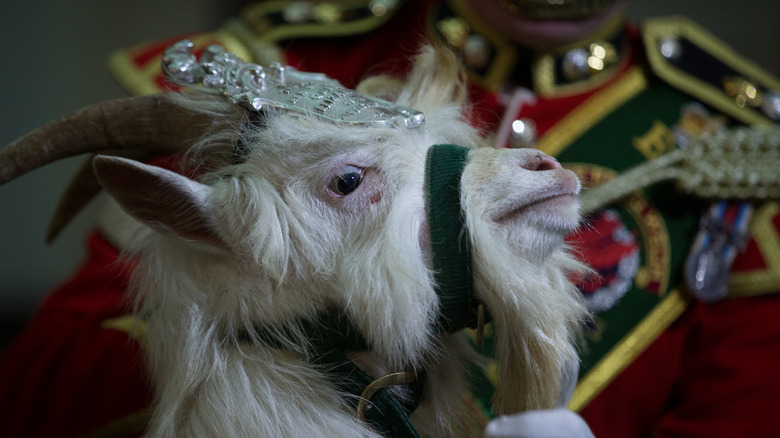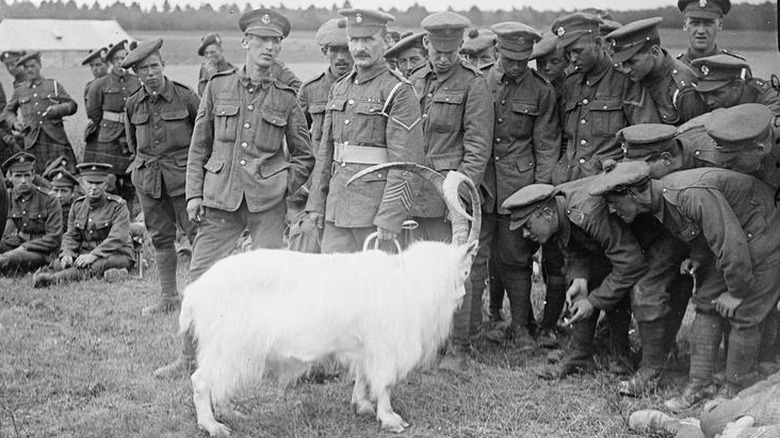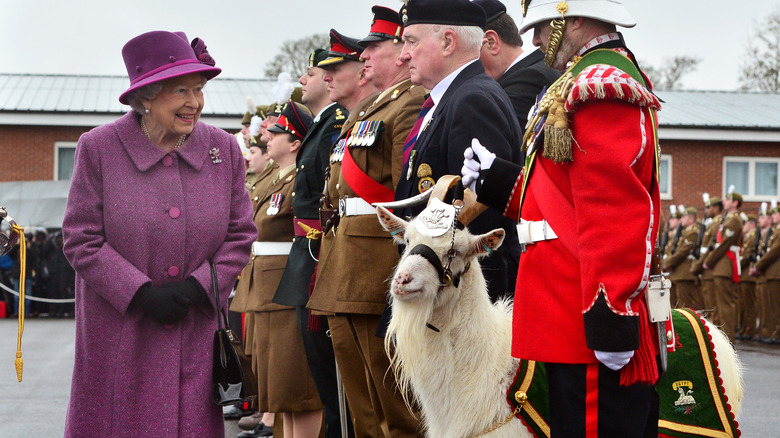The Truth About The Royal Welsh Goat
A unique looking soldier took part in the proclamation at Cardiff Castle at which King Charles III was officially announced as monarch in Wales (via itv). Anyone with an eye for ungulates probably spotted a ranked officer named Lance Corporal Shenkin IV (via The Royal Welsh Museum). Along with 26 regimental soldiers, the lance corporal marched his even-toes from City Hall to the Castle before the proclamation. Shenkin IV is a goat and member of the Regimental 3rd Battalion of The Royal Welsh.
The British Army has a number of official mascots. The Royal Madras have had Bengal tigers, Staffordshire regiments have Staffordshire terriers, and The Royal Welsh will traditionally have goats in their ranks. Treated well, the mascots are entitled to royal army veterinary corps services, housing, and meals. In The Royal Welsh Guard, each regiment might have a goat member with traditional names such as Sospan, Dewi, and sometimes just Billy. But what might surprise a good number of humans is that technically, the goats of The Royal Welsh are not mascots.
A billy at the battle of bunker hill
For over 200 years, The Royal Welsh have employed members of the Capra hircus species (via The Royal Welsh Museum). The tradition is said to date back to the American War of Independence. In 1775, at the Battle of Bunker Hill, a stray goat trotted across the military front. When the goat led the color party — the soldiers carrying and protecting the flags — of the Royal Welsh Fusiliers off the field to safety, they adopted him (via The National Army Museum of the UK). Since that battle's victory, the Royal Welsh have believed that goats bring good luck and regularly adopt them to serve with the regiment.
If requested to tell another historical tale, members of the Royal Welsh might relate for you the story of a soldier in the Crimean War. After saving the Welsh soldier from hypothermia and alerting him of Russian activity, the billy received commendations from Lord Raglan. In 1856, the goat was presented to Queen Victoria, who took a shine to the goat. When the goat passed away, the queen officially presented the regiment with a Kashmir goat. She stated that the successor goat for The Royal Welsh should be from the royal herd. Henceforth, the replacement goat has been obtained as a gift from the monarch. An important technicality: This means the goat is not a mascot but a ranking member of the regiment. King Charles III has yet to comment on the continuation of this tradition under his reign.
A fusilier goat's diet included Guinness and two cigarettes for munching
According to The Royal Welsh Museum, to this day, the goat of The Royal Welsh receives a regiment, rank, snazzy uniform, accommodation, and a salary. Not only that, but the ungulate is subject to promotion and demotion. Such movement in the ranks means that fellow service members are sometimes required to salute the animal.
In 2006, a goat named Lance Corporal William "Billy" Windsor was demoted for an embarrassing outburst, in front of the queen, no less (via The National Army Museum of the U.K.). While leading the front of a parade, Billy marched forward, out of line, and tried to go head-to-head with the battalion's drummers. After being very baaaaaaaah-d, he eventually regained his rank before his retirement in 2009 to the Whipsnade Zoo. While in the service, Billy received two cigarettes a day to eat, as well as Guinness to drink.
Upholding this tradition isn't an easy process. It took a dedicated four weeks before the latest Shenkin was caught on the grounds of Great Orme County Park in 2018 (via itv). A dedicated goat major raises, grooms, exercises, and trains the kid for six months or more, preparing them for crowds, noise, and military and sporting events. In addition to other Welsh national emblems like red dragons, daffodils, and leeks, goats also hold a prominent position in the Welsh identity and military tradition (via The Museum of Wales).


